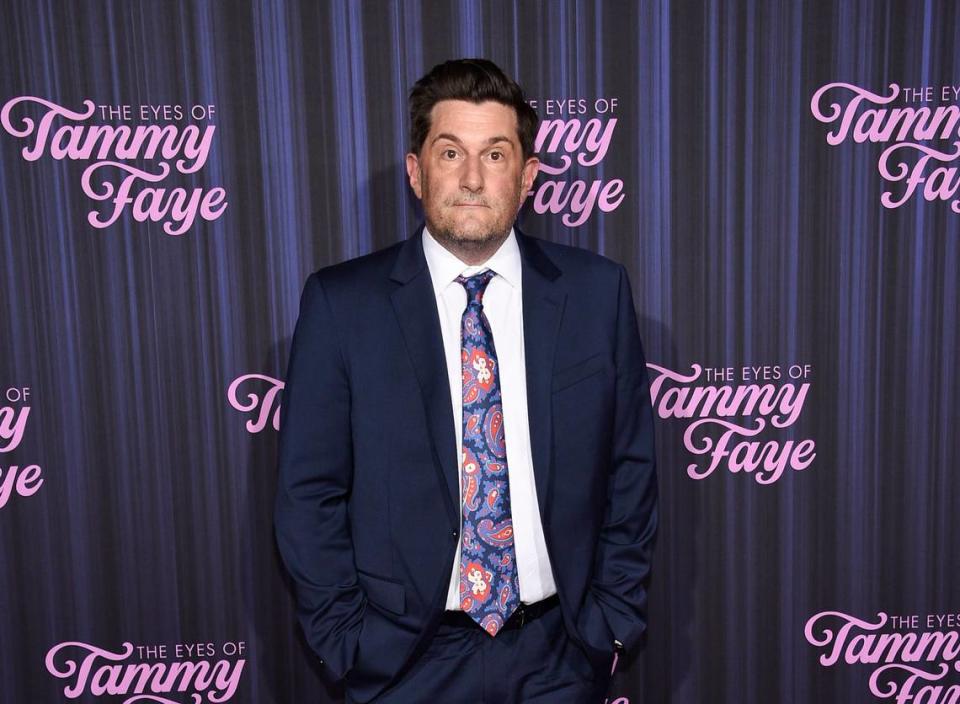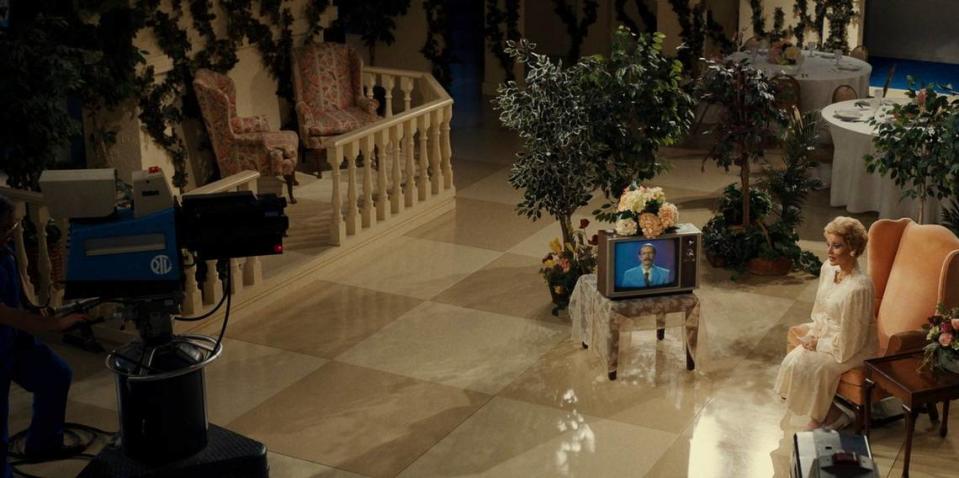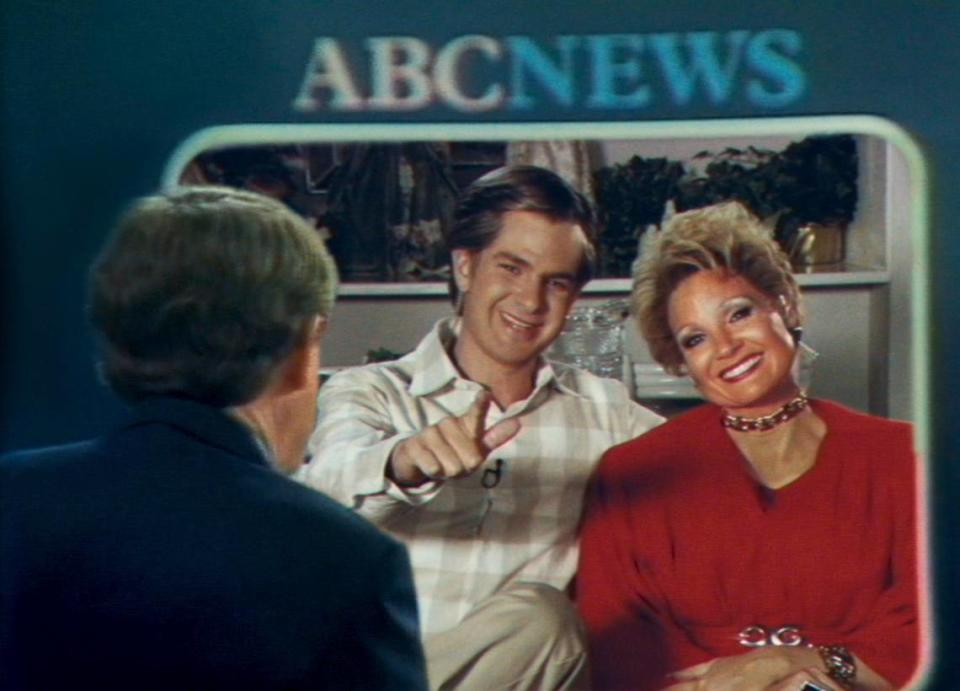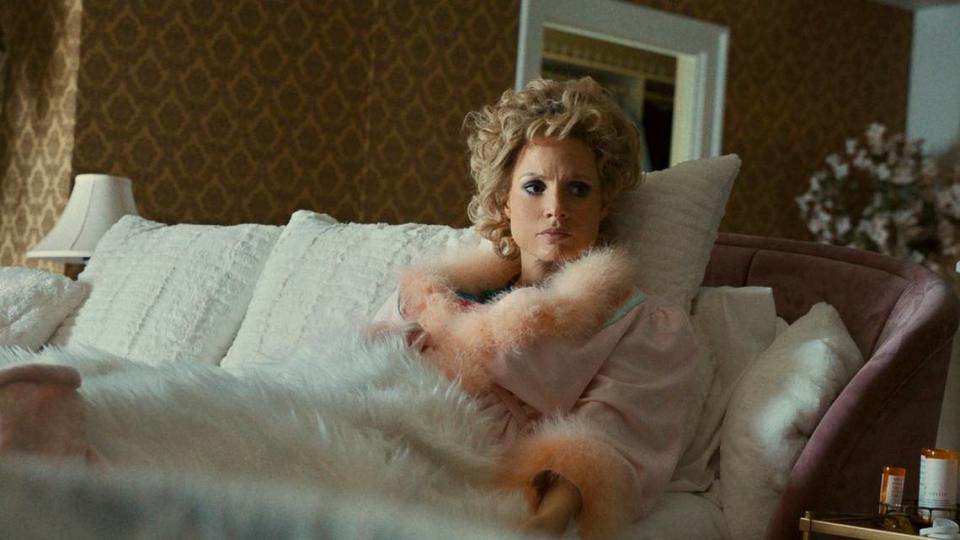How Charlotte figures into the new Tammy Faye Bakker movie — in more ways than one
- Oops!Something went wrong.Please try again later.
- Oops!Something went wrong.Please try again later.
It takes just over 40 minutes for the new biographical film about Tammy Faye Bakker to reach its final destination of Charlotte, North Carolina, where the co-founder of the infamous PTL Club set up shop with her televangelist husband Jim Bakker in 1974.
In real life, however, the cast and crew of “The Eyes of Tammy Faye” were there all along.
Director Michael Showalter says the entire movie was shot in and around Charlotte between September and December of 2019, and that areas of the Queen City and its suburbs play themselves while also standing in for settings in California, Minnesota and Virginia. (They actually wanted to cross the border to film in South Carolina, but didn’t. More on that in a minute.)
With Oscar buzz swirling around Jessica Chastain’s portrayal of the title character, the movie — which pits the rise and fall of the Bakkers’ marriage against the backdrop of the scandals that toppled PTL — is arguably the most significant to be both set and filmed primarily in Charlotte in recent memory.
It’s based on the 2000 documentary of the same name, with Tammy Faye a willing participant in that film. She died of cancer in 2007. Five years after her death, Chastain acquired the rights to the story. Now, nine years after that, it’s finally ready for audiences.
“The Eyes of Tammy Faye” opens in theaters nationwide on Friday.
As this incarnation is not a documentary, there’s creative license involved. There also are notable actors in prominent roles, including Andrew Garfield (“Hacksaw Ridge”) as Jim Bakker, Vincent D’Onofrio (“Homicide: Life On the Street”) as Jerry Falwell, and Cherry Jones (“Succession”) as Tammy Faye’s mother.
Here are some key things we learned about the making of the movie, based on recent interviews with Showalter and the film’s writer, Abe Sylvia.

1. Asked why it was important to him that “The Eyes of Tammy Faye” be shot in the Charlotte area, Showalter says: “Having the look of the movie feel authentic was so important, and there’s a lot of location in the film that you could not find — not just the architecture, but just the landscape also, the trees and the grass — there’s just a very specific look to it that you can’t find in other parts of the country.”
Showalter says a house on Lake Norman was used in the film for the scenes set at the Bakkers’ 10,000-square foot home on Lake Wylie, S.C., and that the crew re-created the PTL television studio in an old warehouse in the Plaza-Midwood area that the production also used for its office spaces. Those two locations were the setting for several of the movie’s most pivotal scenes.
Part of the reason why they chose Lake Norman instead of Lake Wylie, by the way, is because North Carolina’s tax incentives are better than South Carolina’s. In short, shooting in South Carolina would have cost more in the long run, all other things being equal.
In fact, at one point, Showalter and his team visited the site of Heritage USA, the Bakkers’ former Christian-themed amusement park in Fort Mill, S.C., long-closed and mostly in ruins — “but we couldn’t shoot there, ironically,” he says. “I mean, we had even talked about putting a camera on the North Carolina border and getting a crazy zoom lens or something — but it was not to be.”
The Charlotte Regional Film Commission says “The Eyes of Tammy Faye’s” filmmakers were approved for a grant of up to $3.7 million, and the grant rebates at 25% of the in-state spending.
According to a WSOC story from 2019, some of the shooting that took place outside of Charlotte’s city limits was done on the campus of Barber-Scotia College in Concord and in Mount Pleasant — at the old Mount Pleasant Middle School, Pleasant Memories ice cream shop and Carolina Country Inn.

2. If there’s a slightly campy feel to the movie, that’s because ... well, it was kind of unavoidable.
Though it’s heavy on drama, in some respects, “The Eyes of Tammy Faye” feels vaguely like a comedy, because the main characters tend to act a little weird and talk a little weird and — in Tammy Faye’s case — look a little weird. They’ll often say things that sound so strange or goofy you can’t help but laugh at them.
For example, right before Jim Bakker confesses to Tammy Faye that he has had an affair, he says: “The devil’s coming for me, Tammy.”
“Can we talk about Satan later? You know, I’m trying to feel like myself again,” she replies, in what Jim will later in the scene describe as “that whiny, grating, Betty Boop voice,” as she plasters makeup onto her face.

“I know people have asked that,” Showalter says. “Like, are we making fun of them? Which we’re not. We’re absolutely not. I think that there’s something about the Bakkers that was extreme. They were very extreme. ...
“They have this way of talking and way of being that was something that Jessica and Andrew and all of us talked about a lot. And it’s written in, the way they talk about God, and the things they believe in, and the sort of stilted way they talk, that actually stays consistent throughout the whole movie...
“I think maybe it just takes a little while to acclimate to that. And so the tone is actually consistent, it’s just it takes the audience a little while to realize that this is what these people were like.”
Adds the film’s writer, Sylvia: “We don’t want to come off like we’re making fun of anybody or somehow punching down. It’s like, present them as they were, and that is enough... I think trying to keep them in the human realm is what’s important. I think presenting them as they are without gilding the lily — because they already gilded the lily, right? So it’s like putting a hat on a hat... if you allow yourself to luxuriate in the more extreme, ridiculous places.
“We’re trying not to editorialize, or say, ‘Oh, look here, do you see what we’re doing here?’ I think that’s how you stay away from it just becoming a camp cartoon.”

3. The filmmakers did copious amounts of research, but they stopped short of letting their research guide them too much.
In preparation for writing the script for “The Eyes of Tammy Faye,” Sylvia says he watched thousands of hours of PTL broadcasts in addition to reading “PTL: The Rise and Fall of Jim and Tammy Faye Bakker’s Evangelical Empire,” by John H. Wigger; and “Forgiven: The Rise and Fall of Jim Bakker and the PTL Ministry,” by Charles Shepard, the former Charlotte Observer reporter who anchored the Pulitzer Prize-winning coverage that led to Bakker’s resignation in 1987 and thwarted his return to power.
He also read Tammy Faye’s two autobiographies, Jim Bakker’s autobiography and the autobiography written by the Bakkers’ son, Jamie Charles “Jay” Bakker.
Of the Bakkers themselves, Sylvia says: “These folks — and I say this with generosity — are not the most reliable narrators of their own stories. So I took all of the points of view and tried to come at the project with a sort of new essential truth... by metabolizing all of these points of view. I started writing the characters from a point of view of feeling rather than journalism.”
And so while Sylvia did plenty of research, he says he steered clear of doing any interviews. For example, he didn’t try to talk to people who were in the Bakkers’ circle at the time, or reporters who closely covered the scandal.
“The one thing I didn’t want to do is talk to folks,” Sylvia says. “Once you talk directly to people about stuff, I start to feel too much responsibility for how they might feel about things later on. And it gets in the way of me being able to be creative. But you also want to be ethical in your treatment of folks when you haven’t reached out to them. So hopefully we’ve been able to thread that needle acceptably.”
Showalter, meanwhile, says that while he was in Charlotte making the film he talked to plenty of people who had stories about the Bakkers and PTL.
“Everyone who was above a certain age would have a story about, ‘Oh, well I was a waiter at such and such restaurant and they used to come all the time,’ or ‘I worked at Shoe Barn and Tammy Faye would come to Shoe Barn all the time,’ or Dillard’s,” the director says. “To be immersed in that and to have people be very open about those experiences was a really great aspect of making the movie there.”
Still, when asked if they wound up including anything in the film that they learned from people in the area, even if it was just a small colorful detail, Showalter said he didn’t think so.
Explains Sylvia: “The trick of writing a biopic... is you do have to start killing your babies” — that’s a writing term for having to edit out something you love in order to make your work better — “from the beginning. Jim and Tammy Faye were incredibly self-producing and always entertaining. Their lives were so extreme that you do have to start to curate rather quickly what you choose to include. Otherwise it’ll just kind of be all over the place, you know.
“So it’s a process of vectoring down to its most essential, and for me that is just a story of a marriage that fell apart — like so many marriages do — against this backdrop of the electric church and politics.”

4. The Charlotte Observer has an important role in the film.
In “The Eyes of Tammy Faye,” the newspaper is not represented by actors. There’s no Charles Shepard character, for instance, though the reporter himself did appear in the 2000 documentary. Instead, it’s represented as an existential threat that seems to constantly loom over the Bakkers.
At one point, Tammy Faye’s mother walks into Tammy Faye’s dressing room at PTL Studios and holds up a newspaper while asking her daughter, “Have you seen this? From the Observer. Picture of you and Jim on the front. ‘PTL’s Bakker diverts ministry funds for new building project.’ Now what’s that about?”
“Well, you can’t believe everything that you read in the newspapers, Mom,” Tammy Faye says. “Secular press hates us because we’re winning millions of souls for Jesus.”
In another scene, the Bakkers somberly go on their TV show to tell their viewers they are being unfairly persecuted by the media. The phone banks in their studio immediately light up with calls from people wanting to donate money to PTL.
Though the characters express deep resentment for their hometown paper, Sylvia says: “I actually think Jim and Tammy Faye loved The Charlotte Observer — because they could use the headlines to raise money.”
That is, until the day in 1987 when the Observer published an expose revealing Jim Bakker had used ministry funds to pay more than $200,000 in hush money to cover up a sexual encounter with a young church secretary named Jessica Hahn.
5. In the end, the film is a deeply sympathetic portrait — of Tammy Faye, at least.
“I hope,” Sylvia says, “that (audiences) see that her love of God was genuine and love of her fellow man was completely and utterly sincere, and that that was her purest intent, even as they were building this house of cards, together. That the whole time she thought she was doing God’s work. And it came out of a love of fellow man.
“Now, it got completely corrupted. There is sort of this insatiable kind of unfillable thing that Tammy Faye had. I think people who are that ambitious and relentless in their pursuit have an emptiness that can’t be filled. And I say that without judgment. I think it’s just from writing the characters, like OK, what was the unfillable thing for Tammy Faye that drove her actions?
“But I hope that people come away with a sense that her intentions going into this life — and leaving this life — were pure.”

